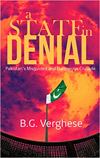|
Home |
Dams, Development, Displacement, TribalsWhy water lies at the root of everything. By B G Verghese Chimanbhai Patel Memorial Lecture, Ahmedabad, June 8, 2006 Chimanbhai Patel was a builder of modern Gujarat with a vision of its future in which the Sardar Sarovar Project figured prominently. I am privileged to deliver this Lecture in homage to his memory. Demand however is expanding. India’s population has tripled and will only stabilise at around 1700 million. There is need to provide for these numbers and, within that, for large cities which can no longer depend on traditional water sources. India will be predominantly urban by 2040. In catering to growing needs, we must keep in mind the pollution factor as well as ecological requirements to ensure sustainability. Groundwater mining even today threatens a crisis. Global warming is evident with glacier retreat and aberrant weather. Hydrological uncertainty demands higher insurance and new coping strategies. As a nation, we are wasteful water users. There are limits to supply expansion. Demand management is vital. Water is a social good at the base level. Above that it is an economic good with a price tag that must cover “production” and delivery costs. Equity is essential, especially with increasing water stress. Almost 80 per cent of India’s water is used for irrigation, much of it from groundwater. This in turn is replenished in part by canal irrigation, which redistributes water over space and time. India is a leading dam builder. But the total storage behind its thousands of dams just about equals the 180 m cu m storage capacity of the Kariba Dam on the Zambezi in Zimbabwe! This is a consequence of variable geometry prevailing in different topographies. High dams on steep gradients that characterize India store relatively little water. In order to utilize the nation’s water assets more optimally, a national water perspective was drawn up in 1980. This has now translated into a proposal for Inter-Linking Rivers to explore the possibility of inter-basin transfers – an age old practice and nothing new - subject to techno-economic, political, human and environmental considerations, in order to provide greater water security for all, with regional and local equity. The ILR concept – and it is no more than a concept, and not some mammoth, cut and dried project – has ill-advisedly been given the name it bears, which is at best a methodology and not an objective. The Par-Tapi-Narmada link is one possible component of this idea and could be taken up in due course if found viable and acceptable on detailed examination. The Par-Tapi-Naramda link as conceived envisages diverting the surplus water of the Par, a small west-flowing stream, to the Ukai reservoir on the Tapi and thence to the Sardar Sarovar lake for the benefit of parched lands further north. The Sardar Sarovar Project itself was the product of prolonged inter-state deliberations and a consideration of many alternatives. It is based on the Narmada Tribunal’s Award of 1979. Its history is well known as the project has been attended with much controversy. What is forgotten is that the generous land-for-land R&R package that was mandated, and continuously upgraded since, was postulated on the availability of degraded forest land. That key assumption was, however, almost immediately negated with the passage of the Forest Conservation Act of 1980. The injunction against diversion of degraded forest lands virtually rendered the land-for-land package somewhat of a false promise in many parts of India. When land-man ratios are shrinking and farm holdings are falling below economic levels, where is all this land to come from? What is on offer at SSP is 2 ha for the primary landowner as a minimum, plus 2 ha each for each coparcener, and his major sons, encroachers and landless labourers. There are other more practical and satisfactory ways of providing R&R. But these have got lost in a clamour that appears to combine outworn ideology with a failure to confront hard realities. Land-for-land has become a mantra that persists to this day for the rehabilitation of all rural DPs. This requires serious rethinking. Where land is available, there is no problem. Elsewhere, “land” is no more than a synonym for the security of gainful employment and a stable income. Hence training, employment and non-land asset-creation, along with a homestead plot or housing, is what is basically required. |
||
| back to the top | |||
HOME | ABOUT THE AUTHOR | LIST OF ARTICLES | CONTACT | BOOKS See also AsianConversations.com 11-C Dewan Shree Apartments, 30 Ferozeshah Rd, New Delhi 110001, India
|


